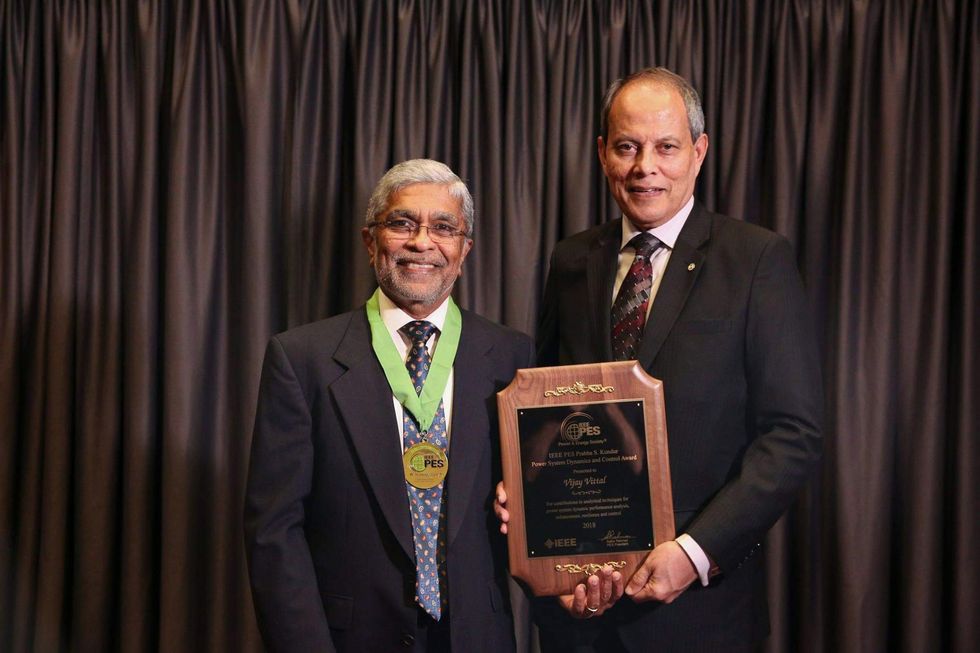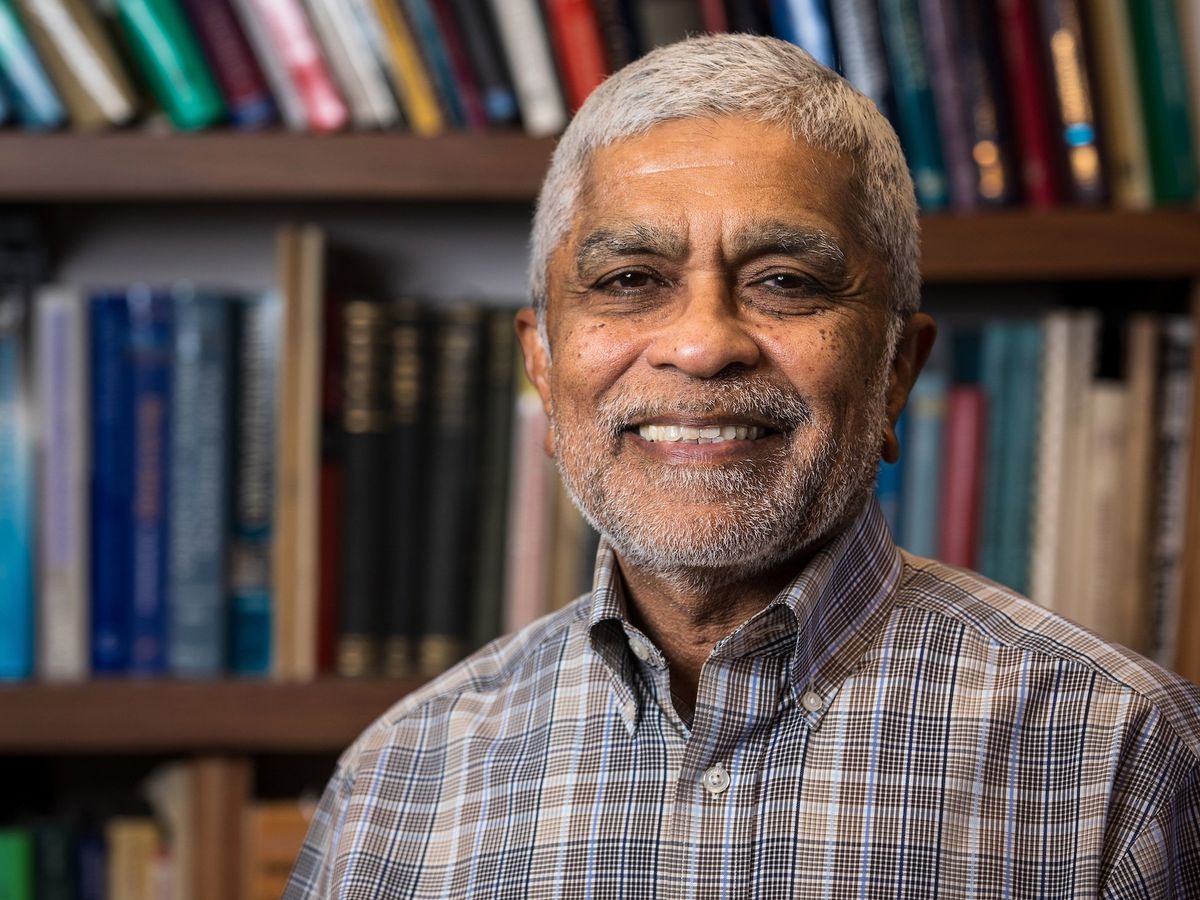Whenever new technologies are introduced into the power grid, there’s always a chance they could disrupt the system, possibly even leading to blackouts.
Finding ways to deal with the impact on the grid caused by incorporating renewable energy has been the focus of Vijay Vittal’s research for nearly 20 years. He is a professor of power systems engineering in the Fulton program at Arizona State University, in Tempe.
The IEEE Life Fellow is credited with working out how best to isolate parts of the power grid to prevent the entire grid from going down.
He was part of an IEEE task force that in 2020 issued a report that described how equipment used for storing energy, transferring power over long distances, and integrating renewable energy could impact power system stability. The report recommended ways to characterize and define the problem.
Vijay Vittal
Employer
Arizona State University, in Tempe
Title
Regents professor of electrical, computer, and energy engineering
Member grade
Life Fellow
Alma mater
B.M.S. College of Engineering, in Bangalore
An article he cowrote that was based on the report received a 2022 IEEE Power & Energy Society Prize Paper Award.
The award was “a welcome surprise,” he says, though “we thought the document turned out very well.”
From synchronous machines to fast response power electronics
That article was an update of a 2004 article that Vittal coauthored as a member of a joint task force formed by the IEEE Power & Energy Society and CIGRE, an international association of power system professionals, headquartered in Paris.
“ Definition and Classification of Power System Stability” addressed systems that, at the time, were dominated by synchronous machines—motors and generators—and their controls. By 2016, fast-acting power electronics were being introduced to the grid, and their characteristics differed from the rotating machines used nearly a decade before.
“These issues required a reevaluation of how we had defined and classified stability in 2004,” Vittal says.
He and others from the PES power system dynamic performance committee and the CIGRE Council of Large Systems’ study committee formed a task force in 2016 to update the 2004 document.
In “ Definition and Classification of Power System Stability: Revisited and Extended,” the committee noted that converter-interfaced generation technology and load and transmission devices were increasingly being integrated, causing the dynamic response of power systems to become more dependent on complex fast-response power electronic devices. The devices include electrochemical storage solutions, high-voltage direct-current lines for transferring power over long distances, flexible alternating-current transmission system devices to help stabilize the grid, and power electronic converter interfaces that integrate renewable energy.
“The synchronous machine has one big advantage,” Vittal says. “It has this natural ability to provide support in terms of the kinetic energy of the inertia, whereas wind turbines and photovoltaic solar systems do not inherently have that capability.
“Renewable systems don’t have the inertia in their systems to keep things spinning. This creates a whole new set of stability issues, performance issues, and characteristics that were not seen in the system when it was primarily dominated by synchronous generators.”

New tools and more engineers
The integration of new technologies into the grid isn’t the only issue, Vittal says. Also needed, he says, are better analytical tools and more power engineers.
The electric grids in the United States and in Europe are interconnected, he says, and planning and operating them requires new tools.
“The computational problem of handling these large systems is enormous,” he says. “We need efficient computational techniques.”
IEEE expands your horizons
Vittal joined IEEE in 1977 as a graduate student. While looking for research topics in the organization’s journals, he discovered plenty in the IEEE Transactions on Power Apparatus and Systems.“That’s when I saw the benefits of student membership,” he says. “I have remained a member ever since.”
He is active in the IEEE Power & Energy Society, serving as editor in chief of the Transactions on Power Systems from 2005 to 2011. He also has been a member of the society’s governing board and has held other roles including vice president of technical activities and technical council chair. He continues to work with both bodies.
Vittal has received many honors from the society, including its 2018 Kundur Power System Dynamics and Control Award, the 2013 Halperin Transmission and Distribution Technical Field Award, and the 2000 Outstanding Power Engineering Educator Award.
“Membership has allowed me to interact with people from all over the world, make connections, and network,” Vittal says. “This has allowed me to not only expand my professional horizons but also my personal horizons. The connections you make and the recognition [received] in terms of being an IEEE Fellow, I think, has a significant bearing on what happens to your career in academia.”
Today’s deterministic analysis shows only whether a power system is tolerant to identified faults and hazards and is safely operating. Vittal says probabilistic tools need to be developed to provide more realistic risk estimates.
Another concern he has is a pending labor shortage.
“Several engineers who have a tremendous amount of experience and an excellent feel for how the systems work are either close to retiring or have retired,” he says. “There is this system memory that is fast disappearing.”
An early interest in power engineering
Power engineering runs in Vittal’s family. His maternal grandfather was chief engineer at a hydroelectric station in Karnataka, India, where Vittal grew up. While pursuing a bachelor’s degree in electrical engineering at the B.M.S. College of Engineering, in Bangalore, Vittal took an elective course on power system analysis. It piqued his interest in power engineering.
Two years after graduating in 1977, he earned a master’s degree in EE at the Indian Institute of Technology, Kanpur. He was inspired to work on power system stability issues by an advisor conducting research in the area.
Vittal moved to the United States to pursue a Ph.D. in EE at Iowa State University, in Ames. After he graduated in 1982, he accepted a position at the university as a faculty member. He taught power engineering there for 22 years, with a break in 1993 and 1994 to serve as power systems program director for the U.S. National Science Foundation’s Division of Electrical and Communication Systems, in Washington, D.C. The NSF recognized him in 1985 with its Presidential Young Investigator Award.
He left Iowa State in 2005 to join Arizona State, where he has served as director of its Power Systems Engineering Research Center. In 2019 he was named a regents professor, the highest faculty position.
He says he has never been interested in getting a job in industry.
“I like working with students,” he says. “Working with young people recharges my batteries.”
Kathy Pretz is editor in chief for The Institute, which covers all aspects of IEEE, its members, and the technology they're involved in. She has a bachelor's degree in applied communication from Rider University, in Lawrenceville, N.J., and holds a master's degree in corporate and public communication from Monmouth University, in West Long Branch, N.J.



